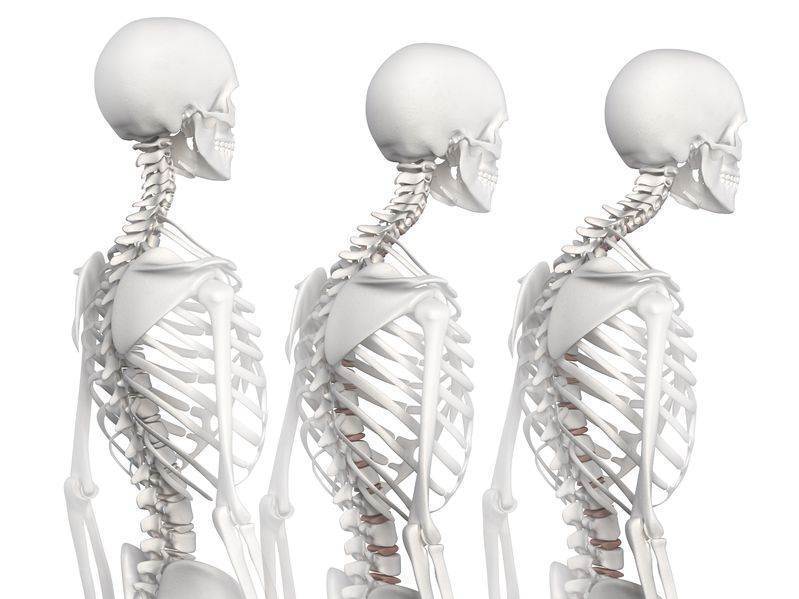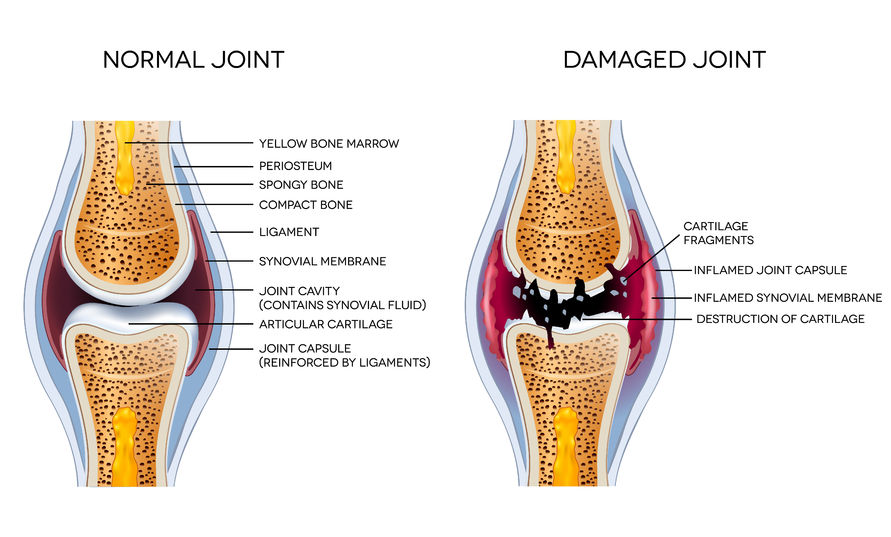Torn Meniscus Exercises for Post-Surgery Recovery Part 1

Optimize Your Recovery from Meniscus Tear Surgery with Targeted Exercises
Recovering from knee meniscus surgery requires a tailored exercise regimen designed to strengthen and heal your knee. The path to regaining full strength is a journey of dedication and carefully selected exercises, suitable for anyone looking to make a full recovery.
See Also: Advanced Knee Meniscus Tear Exercises After Surgery
Recovery Duration:
While NBA players like Jeremy Lin have returned in as little as 6 weeks, Your recovery timeline may extend up to 6 months. Factors influencing this estimate include:
- 3-6 Month Rehabilitation Window: Standard recovery time for meniscus repair.
- Professional Treatments: Regular sessions with chiropractors or physiotherapists can accelerate healing.
- Nature of Injury: A less severe meniscus tear, assuming it’s a repair-only situation, compared to a more complex ACL injury.
Key Exercises for Meniscus Tear Recovery: Details Below
- Leg Pumping Exercises: Activate and enhance blood flow to the knee area, promoting faster healing.
- Knee Extension and Flexion Exercises: Crucial for restoring your knee’s range of motion post-surgery.
- Quad Setting – Isometric Contraction: Strengthens the quadriceps muscles, which are essential for knee stability.
- Straight Leg Raises: Aims at reinforcing strength and stability in the knee.
- Inner Leg Exercise – Side Straight Leg Raises: Targets the adductor muscles, supporting overall leg strength.
What is Degenerative Disc Disease DDD? A Comprehensive Guide
These exercises, when incorporated into your routine, can contribute to a speedier recovery post-meniscus surgery. Whether you’re an elite NBA athlete like Derrick Rose or an everyday individual, commitment to rehabilitation exercises is key to reclaiming optimal knee function. Remember, consult with your healthcare professional before initiating any exercise program post-surgery.
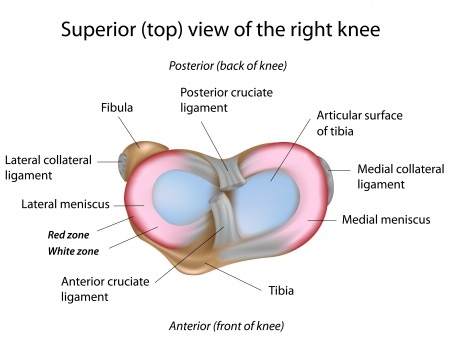
Meniscus Tear: What is it?
You have two menisci (plural for meniscus) in each knee. One is the “medial meniscus” on the inside of the knee and the “lateral meniscus” is on the outside like in the above picture.
Your menisci are “C” or crescent-shaped cartilage that distributes your weight. Without the menisci cartilage the pressure on your knee would increase by 23-335% [1] Your menisci also provides shock absorption and joint stability
Derrick Rose had a repair to his meniscus tear. This means that they sewed the tear in his meniscus. Since the outside of the meniscus has good blood flow it usually heals quite well so is amenable to being sutured (repair with sutures in the picture below). The inner part of the meniscus has poor blood flow and doesn’t heal well, so is often just cut out ( partial menisectomy in the picture below).
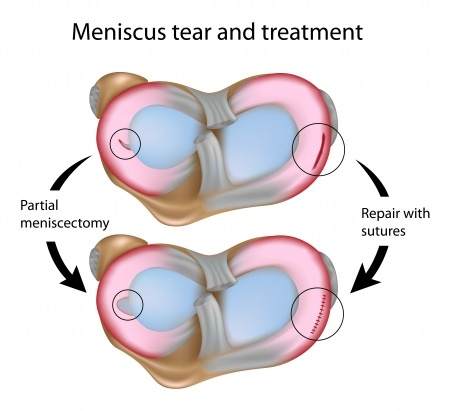
It is better to have a repair to your meniscus compared to a partial removal. This would prevent having another meniscus surgery shortly about ten years later, and likely slow down osteoarthritis from coming on as quickly.
Choosing the right treatment and following a structured exercise program post-surgery can prevent further issues and slow the progression towards osteoarthritis.
Here are the exercises you should do for your rehabilitation after meniscus tear surgery.
Icepacks (Week 1-2)
- Initially, gel packs wrapped in a “J” cloth or very thin towel should be put on the front of the knee over the knee cap for 10 minutes 5 times a day.
- Put the icepack behind the knee for 10 minutes 5 times a day.
You should start the meniscus tear rehabilitation exercises the next day if there are no complications like infection.

Keep Your Blood Moving (Week 1-4)
To keep your blood moving you need to stimulate the muscles in your calf.
- Sit up with your leg supported in bed or a chair with your legs up.
- Pump your foot up and down which has a pumping effect on the veins.
You don’t want to have a blood clot from being too still.
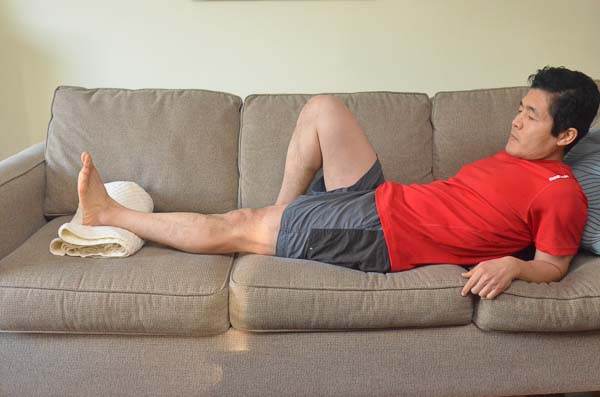
Increase Your Knee Movement (Week 1-4)
Extension: You need to be able to straighten your leg to walk. This means that you need to have full extension (straighten leg).
- Sit up in bed.
- Put a towel or cushion under the heel to so that the knee can straighten out fully.

Flexion: Heel slides
You need to get at least 90 degrees of flexion to get about in everyday life or do most sports.
- Sit up in bed
- Slide your heel towards your buttock. Help with your hands if you need to.
- Don’t bend your knee past 90 degrees. 3 sets of 10.
When you have enough range of motion to peddle a bike, get on a stationary bicycle and do 5 minutes to start and work your way up to 30 minutes. This will strengthen the quads and hamstring muscles needed to stabilize the knee with your repaired meniscus tear.
Isometrics (Weeks 1-4)
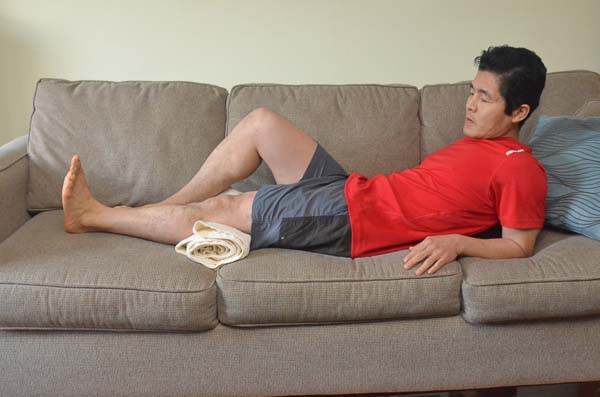
Quad setting -Contracting your quadriceps
- Sit up in bed.
- Put a towel under your knee and contract your quadriceps muscle (front thigh muscle).
- Push the knee into the towel -10 seconds 10X per day.
Body Weight Exercises (Weeks 2-6)
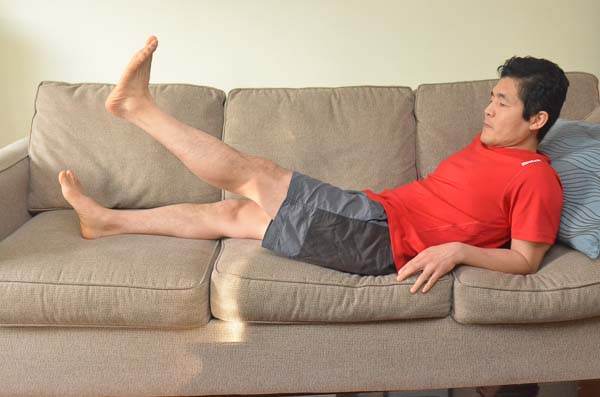
Straight Leg Raise
- Lie face up resting on your elbows.
- Bring your surgically repaired leg up 12 inches / 30 cm off table (hold up to 10 seconds, 8-12 repetitions)
- Advanced: Use a Theraband to provide resistance
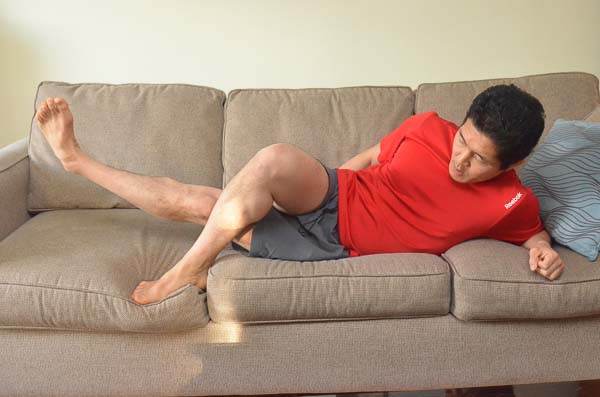
Inner leg exercises
- Side posture with repaired meniscus tear leg down, and good leg bent.
- Bring the injured leg up to about 30 degrees
- Bring the leg up and down 20X
Next week stay tuned for the advanced post-meniscus tear surgery exercises.
Tell us what you think in the comments below and like us on Facebook. This Toronto Downtown Chiropractor will answer all questions in the comments section.





